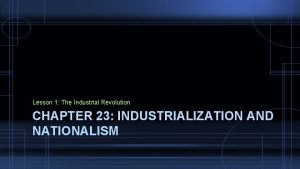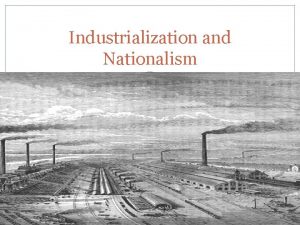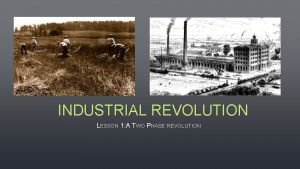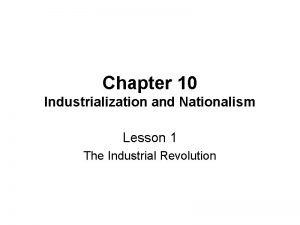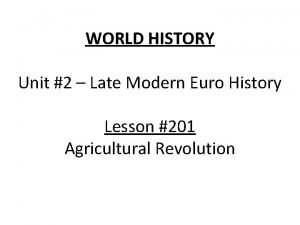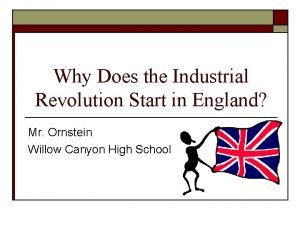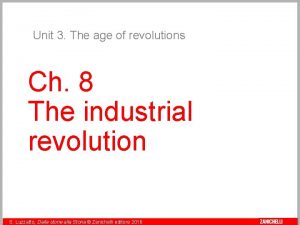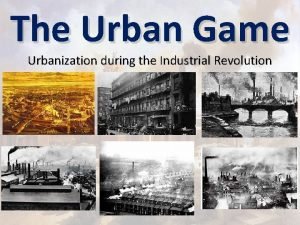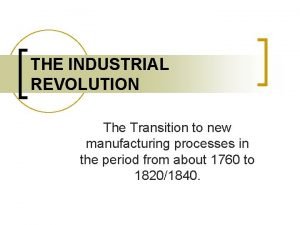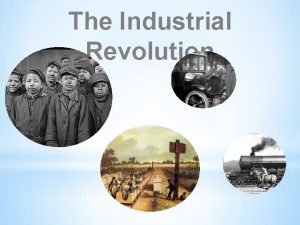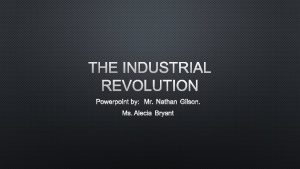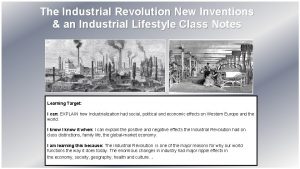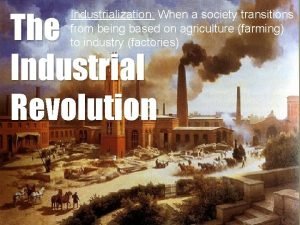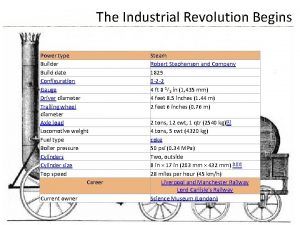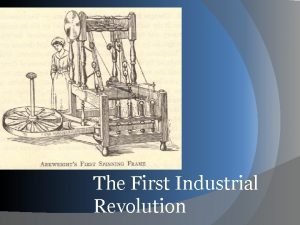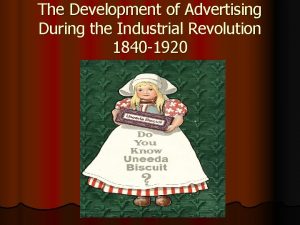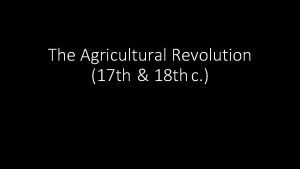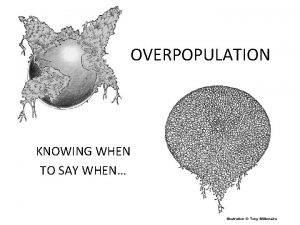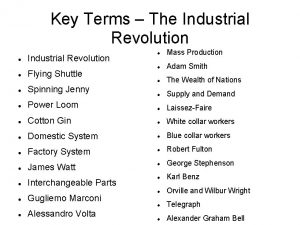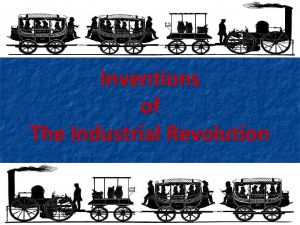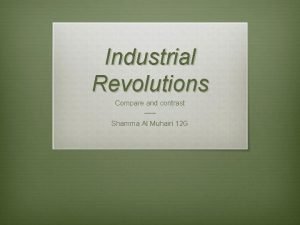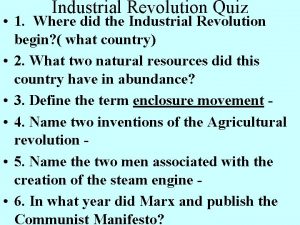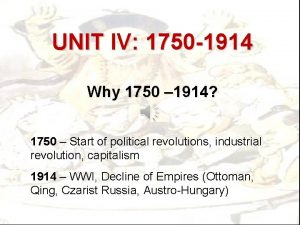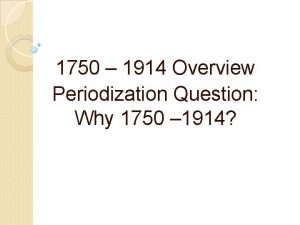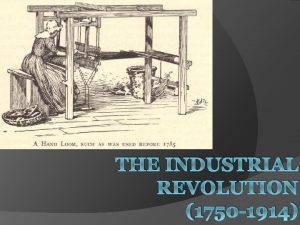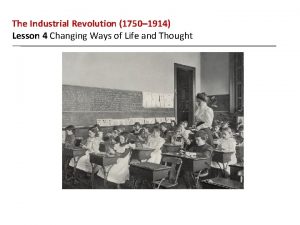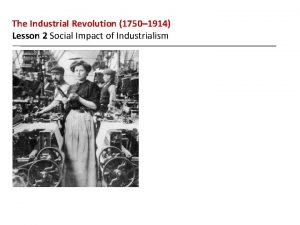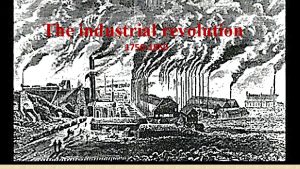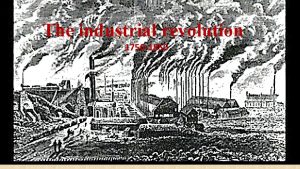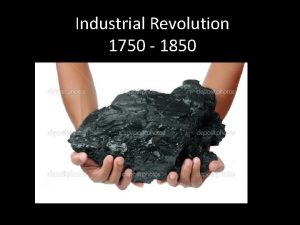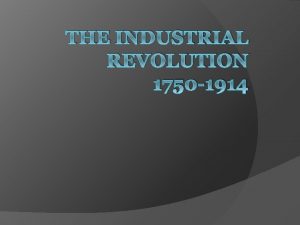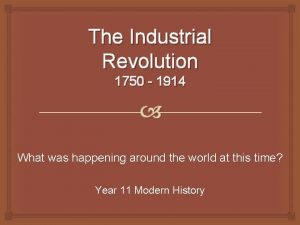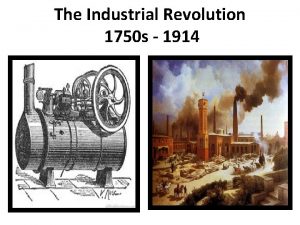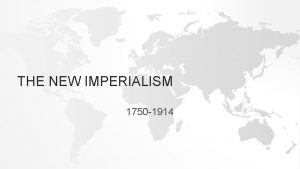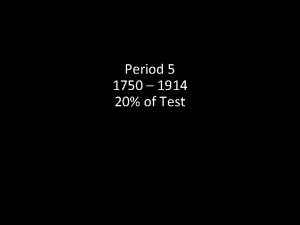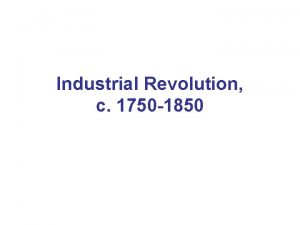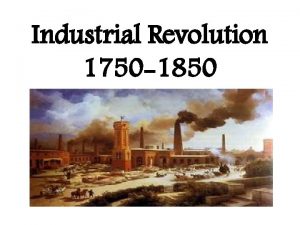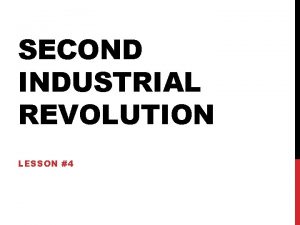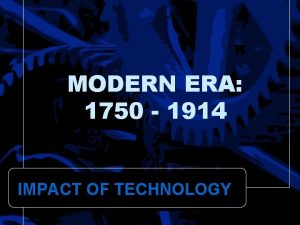The Industrial Revolution 1750 1914 Lesson 3 The































- Slides: 31

The Industrial Revolution (1750– 1914) Lesson 3 The Second Industrial Revolution

The Industrial Revolution (1750– 1914) Lesson 3 The Second Industrial Revolution Learning Objectives • • • Describe the impact of new technology on industry, transportation, and communication. Understand how big business emerged. Summarize the impact of medical advances in the later 1800 s. Describe how cities changed and grew. Explain how conditions for workers gradually improved.

The Industrial Revolution (1750– 1914) Lesson 3 The Second Industrial Revolution Key Terms • • • • • Henry Bessemer Alfred Nobel Michael Faraday dynamo Thomas Edison interchangeable parts assembly line. Orville and Wilbur Wright Guglielmo Marconi stock corporations cartel germ theory Louis Pasteur Robert Koch Florence Nightingale Joseph Lister urban renewal mutual-aid societies

Science and Technology Change Industry The first phase of industrialization was forged from iron, powered by steam engines, and driven by the British textile industry. By the mid-1800 s, the Industrial Revolution was entering a new phase in which new factories powered by new sources of energy used new processes to turn out new products. At the same time, new forms of business organization led to the rise of giant new companies.

Science and Technology Change Industry • • The Bessemer Process Transforms Steel Innovations in Chemistry Electricity Replaces Steam Power Improved Methods of Production

Science and Technology Change Industry By the late 1800 s, steel was the major material used in manufacturing tools. Analyze Graphs Between 1890 and 1910, which nation had the greatest increase in steel production? The smallest?

Science and Technology Change Industry The electric dynamo, shown here, was invented by Michael Faraday in 1831. Dynamos generated the electricity used to power lights in factories and homes.

Advances in Transportation and Communication During the second Industrial Revolution, transportation and communications were transformed by technology. Steamships replaced sailing ships, and railroad building took off. In Europe and North America, rail lines connected inland cities and seaports, mining regions, and industrial centers. In the United States, a transcontinental railroad provided rail service from the Atlantic to the Pacific. In the same way, Russians built the Trans. Siberian Railroad, linking Moscow in European Russia to Vladivostok on the Pacific. Railroad tunnels and bridges crossed the Alps in Europe and the Andes in South America. Passengers and goods rode on rails in India, China, Egypt, and South Africa.

Advances in Transportation and Communication • • • The Age of the Automobile The First Airplane A Communications Revolution

Advances in Transportation and Communication Construction of the Trans-Siberian Railroad began in 1891. Work continued on various parts of the line until 1916.

Advances in Transportation and Communication Analyze Information How did the Trans-Atlantic cable affect communications?

The Rise of Big Business By the late 1800 s, what we call “big business” came to dominate industry. Big business refers to an establishment that is run by entrepreneurs who finance, manufacture, and distribute goods or services on a large scale. As time passed, some big businesses came to control entire industries.

The Rise of Big Business • • • Investors Form Corporations Monopolies Dominate Industry Opposing Views of Big Business

The Rise of Big Business Corporations offered business people several advantages. Analyze Information What advantages did stockholders gain from the formation of corporations?

The Rise of Big Business Alfred Krupp was the first industrialist to use the Bessemer process in Europe. Known as the 'Cannon King, ' Krupp produced cast-steel cannons and other weapons of war.

Better Medicine, Nutrition, and Health The population explosion that had begun during the 1700 s continued through the 1800 s. Between 1800 and 1900, the population of Europe more than doubled. This rapid growth was not due to larger families. In fact, families in most industrializing countries had fewer children. Instead, populations soared because the death rate fell. Nutrition improved, thanks in part to improved methods of farming, food storage, and distribution. Medical advances and improvements in public sanitation also slowed death rates.

Better Medicine, Nutrition, and Health • • Combating Disease Improving Hospital Care

Better Medicine, Nutrition, and Health Longer life expectancies contributed to population booms in major cities. Analyze Graphs Which city's population grew the most? How did life expectancy change between 1850 and 1910?

Better Medicine, Nutrition, and Health The first person Louis Pasteur vaccinated was a nine-year-old boy named Joseph Meister, who had been bitten by a rabid dog. Meister failed to develop rabies.

City Life Changes As industrialization progressed, cities came to dominate the West. Cities grew as rural people streamed into urban areas for work. By the end of the 1800 s, European and American cities had begun to take on many of the features of cities today.

City Life Changes • • New Cityscapes Safety, Sanitation, and Skyscrapers Life in the Slums The Lure of City Life

City Life Changes This aerial view shows Paris around 1870, after being redesigned by Georges Haussmann.

The Working Class Wins New Rights Workers tried to improve the harsh conditions of industrial life. They protested low wages, long hours, unsafe conditions, and the constant threat of unemployment. At first, business owners and governments tried to silence protesters. By mid-century, however, workers began to make progress.

The Working Class Wins New Rights • • The Growth of Labor Unions An Improved Standard of Living

The Working Class Wins New Rights This emblem comes from a United Mine Workers of America poster. Notice the motto beneath the name of the union. Analyze Images Why do you think the union chose that motto?

Quiz: Science and Technology Change Industry How did Thomas Edison's invention of the light bulb affect industry? A. B. C. D. Electric lights made it possible for factories to run after dark. Having better lighting largely eliminated industrial accidents. Bulb manufacturing became the biggest industry in the United States. Brighter lights made people more productive so they worked fewer hours.

Quiz: Advances in Transportation and Communication Which of the following had the greatest impact on transportation during the second Industrial Revolution? A. B. C. D. the steam engine the internal combustion engine the Bessemer process the dynamo

Quiz: The Rise of Big Business Why did some business owners form corporations? A. B. C. D. to regulate the free-enterprise system to buy more stock in competitors' companies to raise money to expand into different areas to create a laissez-faire economy

Quiz: Better Medicine, Nutrition, and Health Which factors caused the population of Europe to soar between 1800 and 1900? A. B. C. D. Cities grew, and families had more children. People bathed more and ate less. The poor were treated at hospitals and survived surgeries. Medicine advanced, and the death rate fell.

Quiz: City Life Changes Which of the following changes to city life would be most likely to reduce the crime rate? A. B. C. D. installing street lights constructing sewer systems erecting fine buildings offering public entertainment

Quiz: The Working Class Wins New Rights Why did some workers organize unions? A. B. C. D. to support large corporations to help women get factory jobs to reduce work stoppages to improve their working conditions
 Chapter 23 lesson 1 the industrial revolution
Chapter 23 lesson 1 the industrial revolution Chapter 10 industrialization and nationalism
Chapter 10 industrialization and nationalism The industrial revolution lesson 1
The industrial revolution lesson 1 Industrialization and nationalism lesson 1
Industrialization and nationalism lesson 1 Russian revolution vs french revolution
Russian revolution vs french revolution You should hope this game will be over soon
You should hope this game will be over soon The third agricultural revolution
The third agricultural revolution Enclosure movement
Enclosure movement Why did the industrial revolution start in britain
Why did the industrial revolution start in britain Industrial revolution zanichelli
Industrial revolution zanichelli Urban game industrial revolution
Urban game industrial revolution Enclosure movement industrial revolution
Enclosure movement industrial revolution Putting-out system
Putting-out system Industrial revolution transition
Industrial revolution transition Industrial revolution quiz
Industrial revolution quiz Industrial revolution powerpoint
Industrial revolution powerpoint Negative effects of the industrial revolution
Negative effects of the industrial revolution The effects of the industrial revolution meme
The effects of the industrial revolution meme Enclosure movement definition industrial revolution
Enclosure movement definition industrial revolution 1st industrial revolution
1st industrial revolution Industrial revolution advertisements
Industrial revolution advertisements Enclosure movement
Enclosure movement Timeline for the industrial revolution
Timeline for the industrial revolution Thomas malthus overpopulation
Thomas malthus overpopulation Radio shuttle factories
Radio shuttle factories Phonograph industrial revolution
Phonograph industrial revolution First and second industrial revolutions
First and second industrial revolutions Industrial revolution vocabulary
Industrial revolution vocabulary Entrepreneurs industrial revolution
Entrepreneurs industrial revolution Long term impacts of the industrial revolution
Long term impacts of the industrial revolution Quiz 1: development of industrial revolution
Quiz 1: development of industrial revolution Industrial revolution jeopardy
Industrial revolution jeopardy
